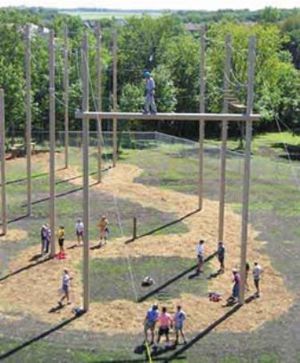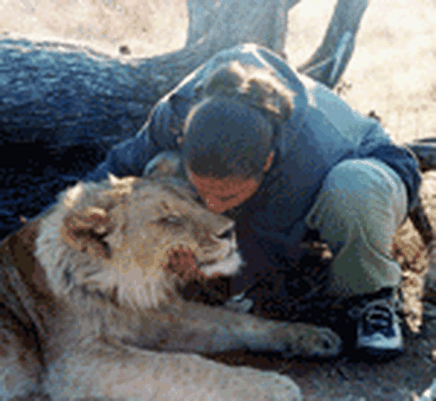The Adventure Education Program
Housed within the Department of Educational Leadership at Minnesota State University, Mankato, one can find the Adventure Education Program. That’s a really long way of saying my university has a ropes course.
To many people, ropes courses (alternatively called challenge courses) are meant only to be played on, spending an afternoon on high elements such as the postman’s walk, the swing, and, of course, the zip line. After unclipping from your belay line, you head home and get back to ‘real life’. A ropes course is nothing more than a fun diversion.
Fun they are, but there’s so much more to be gained from them than an adrenaline rush.
Taking advantage of the Adventure Education Program’s Open House, I was given a tour of the facilities and was introduced to the elements and processing procedures on offer. The course here at MNSU consists of two types of elements – low and high (as determined by their height). Low elements are usually omitted from people’s thought processes when thinking of a challenge course (after all, one doesn’t get that adrenaline rush two feet off the ground). Yet, low initiatives offer some of the best opportunities for team building, communication, and group-reliance training. Most low initiatives are group-based activities that require teams to work together to solve a problem. Each element combines physical and mental exercises, though some are more physical in nature (“The Wall”, for example, in which the group must get everyone up and over a twelve-foot vertical wall without using ropes any or other equipment), while others require more of a mental process (like “The Porthole”, where items must be passed through a tire the size of a ship’s porthole in a certain order).
Regardless of the activity, nothing can be accomplished unless and until the group becomes a cohesive unit that communicates well. “In the beginning of an initiative, there’s usually a lot of miscommunication and conflict. Once people get that out of their systems and start talking to each other, that’s when progress is made,” says Kristina Riggs, a facilitator for the Adventure Education Program with seven years of challenge course facilitation experience under her belt.
The high initiatives, on the other hand, tend to focus more on individual skills and confidence building. Of course, one must trust the person on the other end of their safety line (or belay line) to cut slack and prevent them from crashing to the ground if they fall. But aside from that, the nature of high initiatives pushes an individual’s boundaries and assists them in learning about themselves and their own capabilities- often leading to heightened self-awareness and self-confidence. An example of this would be the postman’s walk- two steel lines or ropes strung across a gap between poles, one atop the other, approximately five feet apart. Crossing from one pole to the other, a person grabs the upper line while standing on the lower line and traverses over. Basic coordination skills aside, one must learn to trust themselves, their abilities, and find a reserve of determination to cross a chasm anywhere from twenty to thirty feet off the ground. Knowing that you’re clipped into a belay line, that safety measures are in place to prevent actual harm, and that facilitators and group members are below you to support you is great, but once you’re up there, you must rely on yourself to get across, or learn to recognize your limitations (a valuable and often underrated skill) and request an early descent.
This last notion- recognizing your limitations- is a large part of the challenge course experience. The concept of ‘challenge by choice’ is an important covenant in the facilitation of ropes courses. As many of the initiatives can be intimidating and difficult, no one is ever expected to complete any given challenge as it is laid out. Rather, each participant discusses with their facilitator what their abilities are and then pre-determines a goal for each initiative on the course. Going back to the example of the postman’s walk, a participant may decide that climbing the pole is their ultimate goal, rather than crossing the ropes. During the ascent, they may then discover that halfway up is, in fact, the threshold of their comfort zone. The individual then makes the choice to challenge themselves and continue up, or alternatively, to accept their boundaries and come down. Either choice will be met with praise from the facilitator- judgment is never applied to what an individual did or did not accomplish physically. The point is in the learning process, not in corporeal or mental ability.
Participating in an initiative is only half of a challenge course. Properly run courses, such as the MNSU program, then take an individual or group (depending on the initiative) into the ‘processing circle’- an area set aside for post-activity discussion. It is in this stage that participants are given time to reflect on their experience and engage in guided discussion in order to fully process what just occurred, and often alternative, ‘better’ solutions are sought and discussed. Various tools for communication are used. My favorite is the Debriefing Thumb Ball, which is covered in polygons like a soccer ball, and inside each shape is a question that relates to and follows the progression of, “What happened?”, “How was that important?”, and “How is that applicable to future situations?”. This spongy ball is tossed out, and the person who catches it answers whichever question their thumb lands on. Another bag of tricks contains plastic replicas of body parts. The point here is for each group member to pick a body part that best represents their role in the previous activity. For example, an ear might be chosen if someone felt they were listening to others. A hand might signify someone who shouldered physical or dexterous work. The team then goes around the circle with each person explaining why they chose a given body part. A similar exercise can be done with a deck of cards containing iconic representations or ambiguous depictions. The main point is to allow people to speak freely while being directed towards a constructive end, both in dissecting what happened and in making suggestions for improvement, without being accusatory or using negative language while discussing the more friction-filled parts of the exercise.
Based on the continuous stream of outside business and repeat customers the Adventure Education Program pulls, it is clear that local and regional businesses believe in the positive benefits reaped from sending their employees through the challenge course. The Adventure Education Program will only host groups and individuals that are looking to gain educational insight and improve their functionality (no birthday parties allowed- the focus here is education, after all), and yet they manage to book up well in advance and stay busy as the weather allows.
Having been on numerous ropes courses before, I’ve personally experienced and can speak to the positive benefits of team building, communication skills, group- and self-reliance skills, and group- and self-confidence they build. And yes, they are extremely fun.

